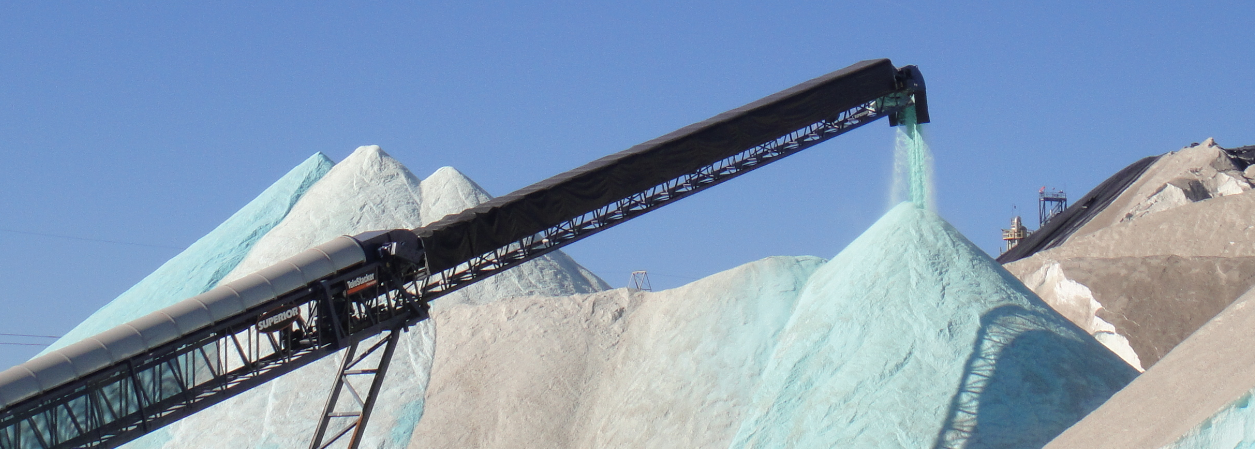Beneath the city of Detroit is the city of salt. The city of salt is a gigantic salt mine, located 1,200 feet beneath Detroit’s surface, spreading more than 1,500 acres. Rock salt was discovered in Detroit in 1895 and has had a rich history ever since.
October 30, 2023 | Staff Editor

Road salt is Detroit Salt Co.’s primary product. They produce approximately 2.5 million tons of salt per year, providing North America with a full line of ice melting products. Snow Plow News took a deeper dive into the history behind Detroit’s salt city.
The Birth of a Salt Mine
Around 400 million years ago, salt deposits formed beneath a portion of Michigan, including the city of Detroit. These deposits came into existence deep beneath layers of sediment within the region known as the Michigan Basin. They materialized as horizontal salt beds, as ancient bodies of water gradually receded and evaporated. This basin, located in the arid reaches of Michigan’s lower peninsula, was separated from the ocean by a natural land barrier. As the basin continued to subside into the earth, salt-rich ocean water repeatedly inundated the depression, only to evaporate slowly, giving rise to extensive salt beds. From its very inception, the Detroit Salt Mine has captivated the imagination of many and has evolved into a contemporary engineering marvel.
The Evolution of the Detroit Mine: From 1895 to the Present
The presence of rock salt in the Detroit region was first discovered in 1895. By 1906, the Detroit Salt and Manufacturing Company was poised to embark on the ambitious endeavor of establishing a local rock salt mine. The journey down to the salt beds marked a remarkable feat of engineering for its time.

Right from the commencement of the first shaft’s sinking, construction crews confronted formidable challenges. The presence of hydrogen sulfide gas and the need to navigate through hundreds of feet of rock and glacial debris proved to be significant obstacles to their progress. Sinking the shaft also proved to be a costly endeavor, leading to the bankruptcy of the Detroit Salt and Manufacturing Company before they could ever reach the coveted salt deposits.
Following a corporate restructuring, the newly formed Detroit Salt Company successfully completed the 1,060-foot shaft in 1910. A mere two years later, the mine changed hands again as it was acquired by the Watkins Salt Company, which incorporated the new entity under the name Detroit Rock Salt Company. After extending the shaft an additional 100 feet, miners began working a second salt bed. This new approach not only enhanced productivity but also yielded higher purity rock salt. The success of the Detroit mine quickly attracted the attention of a competitor, the International Salt Company, which ultimately acquired the mine.
By 1914, the Detroit mine was churning out a monthly production of 8,000 tons of rock salt, primarily serving the leather and food processing industries. Increased investments in personnel, financial resources, and advanced equipment were paying off handsomely. Miners were now employing electric locomotives, mechanical shovels, and electric power to alleviate the physical demands of mining. These technological advancements propelled the Detroit mine to even greater levels of productivity.
In 1922, the company initiated the excavation of a larger, second shaft to expedite the process of hoisting rock salt to the surface. Within three years, the second shaft was operational, while the first shaft was dedicated to transporting personnel and materials. Every piece of equipment currently used in the mine has been lowered through the second shaft. Due to the narrow confines of the shaft, most equipment is disassembled, lowered piece by piece, and then reassembled in a machine shop located below.
In 1983, International Salt decided to cease the mine’s operations. Two years following the shutdown, Crystal Mines, Inc., purchased the mine as a potential storage facility. In 1997, the Detroit Salt Company, LLC, acquired the mine from Crystal Mines, Inc., and resumed salt production in the autumn of 1998. While the leather and food industries were once prominent clients of the Detroit mine, the sole product it currently provides is road deicing salt. The Detroit Salt Company, LLC, employs the latest mining techniques, making it one of the safest, most modern, and efficient mines in the world.

In 2010, The Kissner Group acquired the Detroit Salt Company, LLC, along with ownership of the mine. Today, these two entities work collaboratively to provide North America with a comprehensive range of ice-melting products, including bulk rock salt, bagged rock salt, and premium blended formulations.
To learn more about Detroit Salt Co., or the Detroit salt mine, visit detroitsalt.com.
Detroit salt mine history: Detroit Salt Company. (2023). Genesis of a Salt Mine.
